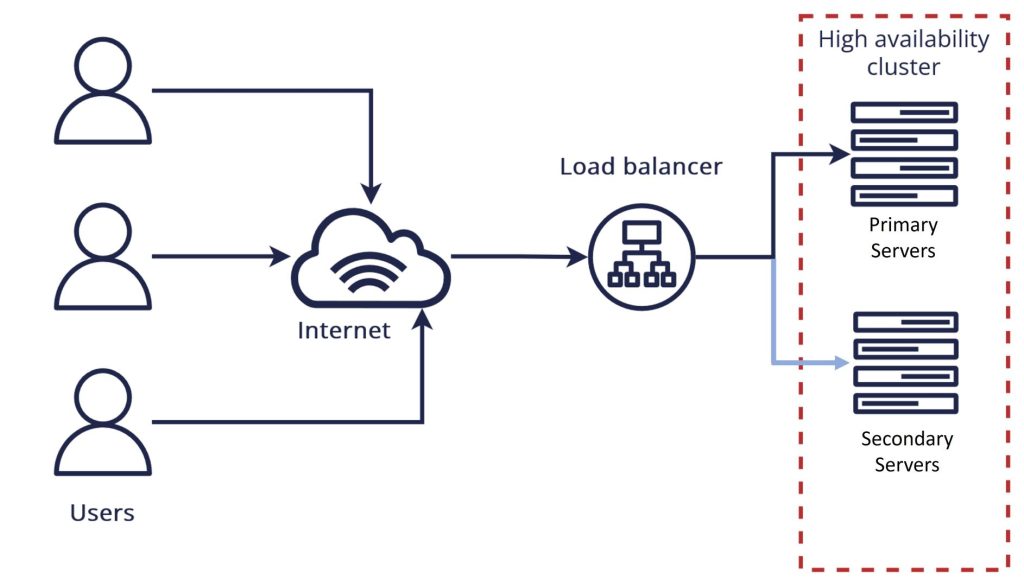
High Availability: Ensuring Your Business is Always On
Technology and networks occasionally fail, such as when there’s a power outage or a server error. Many businesses today rely on continuous uptime in order to deliver services and survive. High Availability (HA) is a success factor that oils the wheel of seamless business operations.
Downtime can lead to loss of revenue, customer dissatisfaction and reputational damage, especially for companies relying heavily on online services.
In this blog, we will discuss what high availability is, its concept, key elements and how Angani can support your business in ensuring high availability.
What is High Availability?

High Availability (HA) refers to the ability of a system or network to operate continuously without failure for an extended period. HA systems are designed to minimize downtime and ensure that critical services are always operational. Uptime is typically measured as a percentage, with 99.99% (often called “four nines”) availability being a common target for businesses seeking high reliability. This means that, over the course of a year, downtime is limited to less than an hour.
High Availability is crucial for industries that demand continuous service, such as e-commerce platforms, manufacturing control systems and financial services.
Types of High Availability
Several types of high availability architectures exist, depending on the needs of the system and the industry. Below are the most common approaches:
In this setup, two or more nodes exist, where one is actively handling requests, while the other(s) remain on standby. If the active node fails, one of the passive nodes takes over.
All nodes in the system are active and handle requests simultaneously. If one node fails, the others continue handling requests, ensuring seamless failover without disruption.
This approach involves deploying servers in multiple geographic locations. If one site goes down due to a natural disaster or other catastrophic events, another site in a different region takes over.
High availability clusters consist of multiple servers working together as a single system. These clusters ensure that even if one server fails, others can seamlessly take over.
How High Availability Works
High availability systems are designed with redundancy in mind, using multiple layers of hardware, software and network solutions to avoid single points of failure. Here’s how it typically works:
The key to HA is redundancy. By having multiple servers or nodes, the system ensures that if one component fails, another is ready to take over.
Load balancers distribute traffic among multiple servers. If one server becomes unavailable, the load balancer redirects traffic to another functioning server, ensuring continuous service.
When a system detects a failure in one part of the infrastructure, it switches to a standby system or server, ensuring that service is not interrupted.
Monitoring tools continuously check the health of the system. Alerts are triggered when performance issues arise or if a component goes down, allowing for quick intervention.
How to Set Up High Availability (Pre-requisites and Best Practices)
Setting up high availability requires careful planning and the right tools. Below are the steps to follow:
1. Assess Business Needs
Determine which parts of your business require high availability. Not every system needs to have 99.99% uptime, but critical systems like databases or customer-facing applications often do.
2. Choose the Right Architecture
Based on your assessment, select the HA architecture that fits your needs: active-passive, active-active, or clustered systems.
3. Deploy Redundant Infrastructure Components and Software
- Cloud Infrastructure: Ensure you have duplicate cloud components, such as multiple servers, storage and network connections.
- Software: Choose HA software solutions, including load balancers, failover software and monitoring tools.
4. Use Reliable Data Storage
Ensure that your storage system also follows high availability principles, with RAID configurations or cloud-based storage solutions that replicate data across multiple locations.
5. Geographic Redundancy
For businesses where uptime is critical, deploy infrastructure in different geographical locations to protect against natural disasters or large-scale outages.
6. Implement Load Balancers and Auto-failover
Utilize load balancers to distribute workloads and implement auto-failover solutions to switch traffic in case of a failure.
7. Monitoring and Alert Systems
Ensure there are real-time monitoring tools in place to identify problems early and send alerts to administrators for immediate action.
How to Test High Availability
Testing is essential to ensure your HA setup works as expected. Here’s how you can do it:
1. Simulate Failures Test your system by intentionally failing a node or server. Check if the failover mechanism kicks in automatically and reroutes traffic.
2. Monitor Performance During Failover Measure the time it takes for your system to failover and recover. Ideally, this should be in real-time or within a few seconds.
3. Load Testing Conduct load testing to ensure that your system can handle traffic during peak times and that all nodes in an active-active configuration share the load efficiently.
4. Security Audits Run regular security audits to ensure that your HA infrastructure doesn’t compromise your data security.
How Angani Can Help Businesses with High Availability Solutions
At Angani, we understand that uptime is critical for your business. Our high availability solutions are designed to ensure your systems are resilient and reliable, minimizing the risk of downtime.

Why Choose Angani for High Availability?
- Tailored Solutions: We work closely with businesses to design HA architectures that fit their specific needs.
- Expert Support: Our team of cloud and infrastructure experts ensures smooth deployment and ongoing management of your HA environment.
- Cloud-Based Flexibility: By leveraging cloud-based solutions, we ensure geographic redundancy and instant scalability for businesses of all sizes.
Whether you’re looking to implement HA for the first time or need help optimizing your current setup, Angani is here to guide you through the process.
FAQs
Q: What is High Availability in cloud computing?
A: High Availability in cloud computing ensures that cloud services are available with minimal downtime, even during hardware or software failures. Cloud providers like Angani use geographic redundancy, failover mechanisms and load balancing to ensure high availability.
Q: How much does it cost to implement High Availability?
A: Costs depend on the size of the system and the level of redundancy required. However, cloud-based HA solutions can be more cost-effective due to on-demand scaling and pay-as-you-go pricing.
Q: How can I know if my system is highly available?
A: Monitoring tools, uptime logs and regular failover testing will help you gauge whether your system meets your desired availability targets (e.g., 99.99% uptime).
Q: Can high availability prevent all downtime?
A: While high availability significantly reduces downtime, it can’t prevent all outages. However, downtime in HA systems is minimized to seconds or minutes rather than hours.
Q: Is high availability necessary for all businesses?
A: Not all businesses need 99.99% uptime. However, if you have critical services like e-commerce, financial transactions, or healthcare data, high availability is essential.
Conclusion
High Availability is not just a luxury for modern businesses—it’s a necessity, especially for industries relying on continuous uptime and seamless service delivery. By understanding the different types of high availability, how it works and the best practices for setup, your business can ensure minimal disruption and improved efficiency.
Angani offers expert services to help businesses implement and maintain high availability systems. Whether you’re just starting out or need to optimize your current infrastructure, our team is ready to support you.

